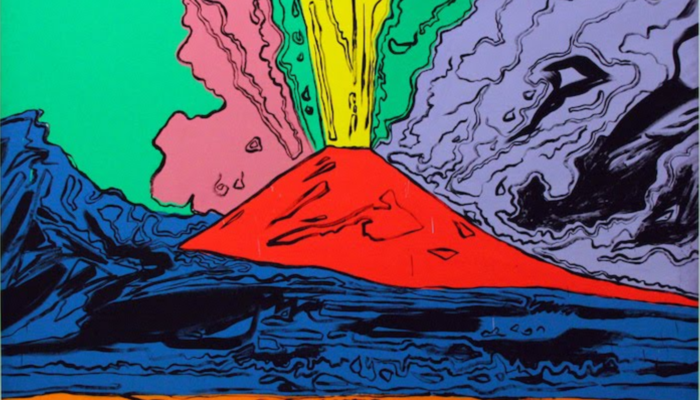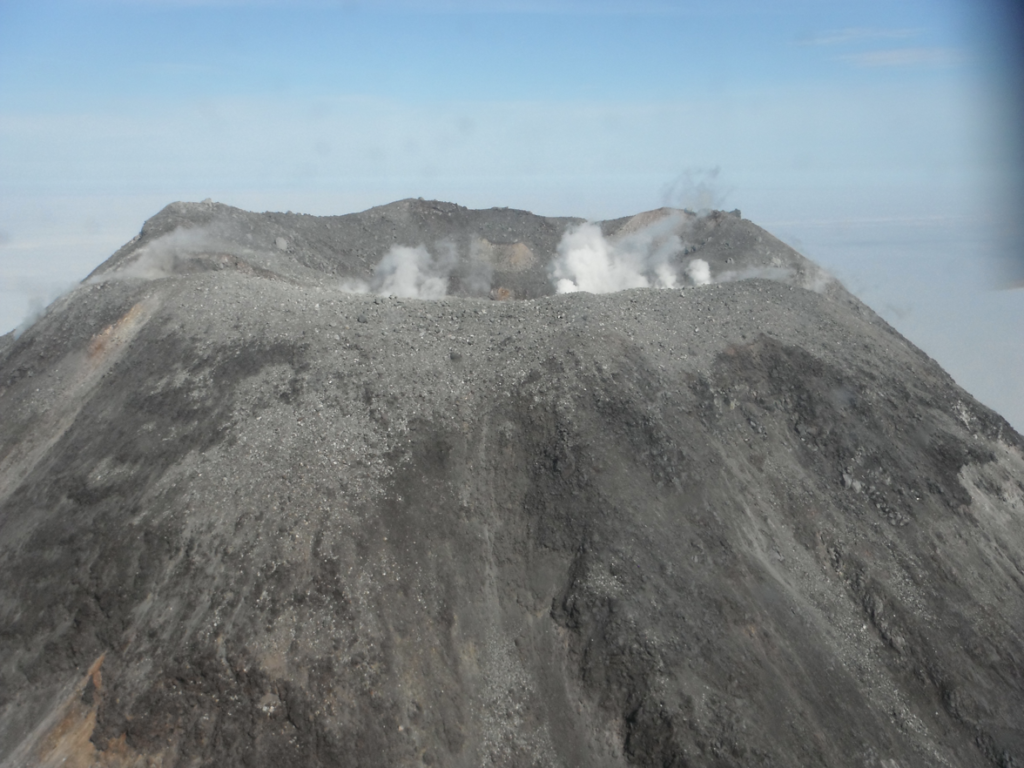
Volcanoes arouse emotions in the soul of men: at the same time, they are fascinating and frighten the population that lives on their slopes when they erupt (Fig. 1). Volcanoes can strike without warning and wreak horrific destruction and death. As such, in the ancient time, volcanoes discharging explosive eruptions have been interpreted as the wrath of gods that destroys and annihilates all around. The fourth book of the Epigrams by the Latin poet Marcus Valerius Martial offers a heartbreaking description of the remaining of Herculaneum after the 79 AD eruption of Mount Vesuvius:
Hic est pampineis viridis modo Vesbius umbris,
presserat hic madidos nobilis uva lacus:
haec iuga, quam Nysae colles, plus Bacchus amavit,
hoc nuper Satyri monte dedere choros.
Haec Veneris sedes, Lacedaemone gratior illi,
hic locus Herculeo nomine clarus erat.
Cuncta iacent flammis et tristi mersa favilla:
nec superi vellent hoc licuisse sibi.
Here is Vesuvius, a little green of shady vineyards,
here a fine grape made the tubs overflow:
Bacchus loved these leaps more than the hills of Nisa,
on this mountain the Satyrs in the past they danced.
This, more appreciated than Sparta, of Venus was the seat,
this was the renowned place for the cult of Hercules.
Now everything lies submerged in flames and in sad ash:
now the gods would not want to have been allowed to exercise so much power here.
At that time, reading the mind of the gods was inscrutable. Nowadays, predicting the unpredictable and inevitable effects of volcanic activity is the tumultuous mission of modern volcanology. Yet despite rapid advances in volcanology, volcanologists still cannot predict when, how, how big the next eruption will be.
Scientists at the Volcanological Observatories inspect the geological past and the present activity of active volcanoes to recognise when the changes of this activity shift from normal background levels. Observo experior praedico (I observe, I explore, and I predict) is what USGS volcanologists successfully conducted forty years ago: they deciphered two-month series of precursory signs of earthquakes, steam-venting episodes, and volcano edifice deformation that were inferred to be the cause of magma injection at shallow depth below Mount Saint Helens volcano (WA, USA) in 1980, after about 120 years of quiescence (Fig. 2). All these precursors helped indicate that an imminent eruption was due. This should have led to claim a caesarean veni vidi vici (I came, I saw, I won) to predict the climactic eruption event and evacuate the local population before the disaster. But still, 57 people lost their lives (including USGS volcanologist David A. Johnston) in one of the largest eruptions of the last century, which scattered volcanic ash across a dozen states in the US, produced shockwaves and pyroclastic flows across the surrounding landscape, flattened the forests nearby, melted snow and ice, and generated massive mudflows following the collapse of the northern portion of the volcano edifice. From the volcanic ashes of this eruption of Mt St Helens modern volcanology was born.

Figure 2 – Eruption of Mt St Helens (WA, US) on May 18, 1980, with John V. Christiansen as a spectator. Picture taken from Mt Adams (WA, US) by Vince Larson around 8:32 am local time on May 18, 1980, and published in a 1981 National Geographic Society magazine.
After 40 years since the eruption of Mt St Helens of May 18, 1980, volcanologists still strive to forecast the likelihood, magnitude, and style of eruptions. In the last year, volcanoes Fuego (Guatemala), Anak Krakatau (Indonesia), Stromboli (Italy), and Whakaari/White Island (New Zealand) erupted violently with unpredicted eruption style and magnitude, resulting in the death of hundreds of people, as well as severe damage to key infrastructures of millions of dollars. For instance, anticipating the magnitude of future eruptions (in other words, the mass of erupted magma) is a vital piece of information for ~800 million people living near ~550 active volcanoes worldwide but remains extremely challenging. More than half of the world’s active volcanoes are not monitored instrumentally. Hence, even eruptions that could have rung an alarm can occur without people at risk having a clue of the upcoming disaster. This is why modern volcanology is key to thriving 21st-century societies aiming to understand geological processes such as volcanic activity. Volcanoes can modulate the Earth’s atmospheric composition and climate, either maintain or perturb biotic equilibria, favour volcanic winters by raising the Earth’s albedo and cooling its troposphere and cause disruption to aviation, telecommunications, and water networks. Therefore, forecasting volcanic eruptions in the short- and long-term has a large influence on the socio-economic and environmental equilibria of planet Earth.
From the volcanic ashes of this eruption of Mount Saint Helens
modern volcanology was born.
Volcanologists as Earth-care professionals who record the warning signs that may foretell the future eruption still struggle in the assessment of the true volume of gas stored in magmas, the true level of magma pressurisation, and the true volume of eruptible magma before the eruption event. The lack of predictable linear correlations between volcanic parameters, such as emitted gas and erupted magma, poses a great challenge in assessing when and how large a volcanic eruption occurs. This issue impedes to forecast the magma’s propensity to release gas, which favours effusive activity, and its capability to retain it, which favours explosive eruptions. In the last 40 years, the international volcanology community has largely contributed to the overall scientific commentary of DE BELLO VULCANICO (On The Volcanic War) by facing two major battlefronts:
1. Deciphering the volcanic precursors
To date, the recent development in technological monitoring of active volcanoes using ground-, air-, and space-borne sensors that measure ground deformation and gas emissions from volcanoes worldwide provides essential insights on the potential of a volcano to erupt and, eventually, on the intensity of an eruption following a period of unrest. Measurements of volcano deformation permit to deduce the size and shape of the magma source at depth using geometric models, and show that volcanoes can experience either deformation or no deformation before their eruption. The puzzling causes of these variations prevent volcanologists from using the amount of deformation to predict the volume of magma that is finally erupted. Satellites easily detect in real-time volcanic SO2 emissions. If one compares the released amount of volcanic SO2 and the corresponding volume of erupted magma, there is an evident disparity between the two parameters. This disparity prevents volcanologists from forecasting the amount of SO2 released into the atmosphere and the real eruption magnitude.
2. Predicting the physics of magma unrest before a climactic eruption event
In combination with igneous petrology as a forensic enterprise to study past eruptions, volcanologists investigate the gas abundances preserved in pristine melt inclusions hosted in minerals from erupted volcanic rocks, which can reveal the gas cargo composition and amount and magma pressurisation at depth. In magma reservoirs at depth, gas bubbles form by degassing of fluid components from the magmatic melt. Degassing and the competition between magma’s capability to retain or release gas exerts a major control on magma ascent and eruption. At low gas volumes, bubbles are sufficiently distant from one another to prevent their connectivity and magmas remain rather impermeable. A gas-rich magma is impermeable until bubbles begin to touch and at least one cluster of interconnected bubbles spans the entire volume and magma becomes permeable to gas flow. Magmas become permeable bodies when a certain gas volume or ‘percolation threshold’ is reached. So far, there have not been clear constraints on how gas percolation threshold is controlled by chemical and physical parameters.

Figure 3 – Kanaga Island (Western Aleutians, Alaska) observed from Bell 407 helicopter of the Maritime Maid vessel during Leg 3 of the large research consortium GEOPRISMS, funded by the National Science Foundation (September 2015). Credit: Mattia Pistone.
The listed battlefronts of DE BELLO VULCANICO, therefore, underline the urgent need of the volcanology community to develop new strategies for decoding the volcanic precursors, forecasting volcanic eruptions, and developing novel risk assessment strategies to save lives and reduce damage property costs. Currently, major research initiatives aim to integrate satellite-based data into existing volcano monitoring platforms, such as Monitoring Unrest from Space (MOUNTS) that apply multisensor satellite-based imagery, ground-based seismic data, and artificial intelligence to assist global monitoring tasks. Deep Earth CArbon DEgassing (DECADE) of the Deep Carbon Observatory that deploys advanced real-time volcanic CO2 monitoring devices on twenty of Earth’s most actively degassing volcanoes, and Anticipating Volcanic Eruptions in Real-Time (AVERT) that deploys an array of instruments in the Aleutian Islands (Alaska, USA) to improve forecasts of volcanic eruptions (Fig. 3). As identified in the Volcanic Eruptions and Their Repose, Unrest, Precursors, and Timing (ERUPT) report of The National Academy of Sciences, accurate forecasts of the likelihood and magnitude of an eruption in a specified timeframe are rooted in a scientific understanding of the processes that govern the storage, ascent, and eruption of magma. Therefore, it is a crucial mission for the 21st-century volcanologists to unravel the predictability of volcanic phenomena by synergising modern technology with observational, laboratory, and computational volcanology. Defeating the ignorance of the causes of volcanic eruptions is the way that we “were not made to live as brutes, but to follow virtue and knowledge” (Dante Alighieri, Divina Commedia Inferno, canto 26, l.118). The effort of observo experior praedico has to continue to predict the unpredictable effects of volcanic activity. Ālea iacta est (The dice has been cast).
About the author.
Mattia Pistone was awarded BSc in Geological Sciences at Università G. D’Annunzio in Chieti and MSc in Geodynamics, Geophysics, and Volcanology at University of Rome La Sapienza (Italy). He obtained a PhD in Earth Science at ETH-Zurich (Switzerland) after completing the research project on “Physical Properties of Bubble- and Crystal-bearing Magmas”. He conducted postdoctoral research projects on magma transport and chemical evolution in the crustal domain at the University of Bristol (United Kingdom) and the National Museum of Natural History of the Smithsonian Institution (Washington, DC, USA). He was a Maître Assistant (lecturer) at the University of Lausanne (Switzerland) where he explored the fluid transport in the deep crustal realm of the Western Alps. He is currently Assistant Professor in Petrology and Volcanology at the University of Georgia (USA). He is director of the MAGMA MIA Laboratory, one of the six PIs leading the ICDP DIVE (Drilling the Ivrea-Verbano zonE) project, and an enthusiastic researcher investigating the mechanics of multiphase magmas, eruption dynamics, and volatile cycles in the Earth’s interior using a combination of experimental, analytical, and field-based approaches.
Post edited by Valeria Cigala, Giulia Roder, Asimina Voskaki
